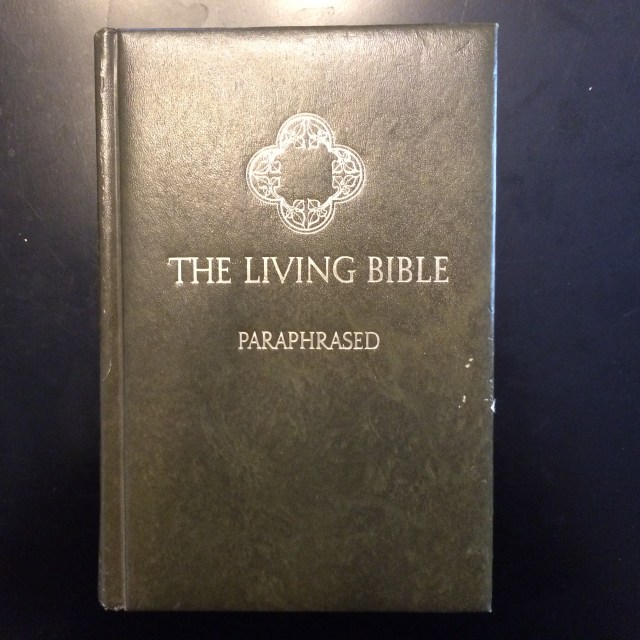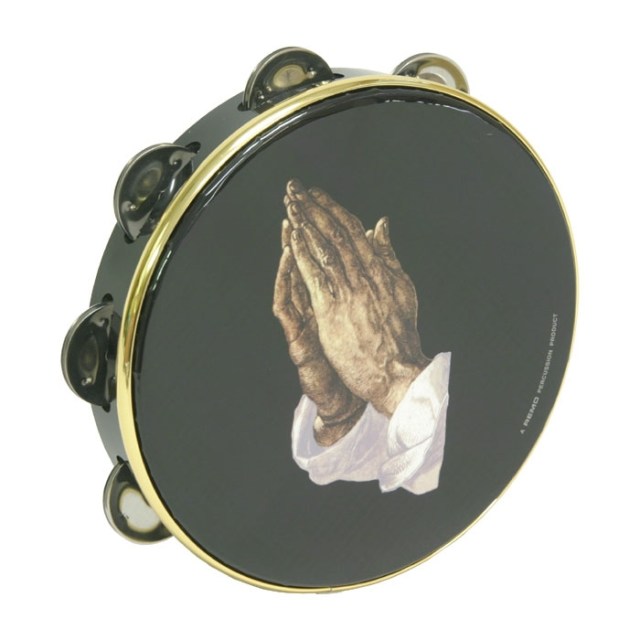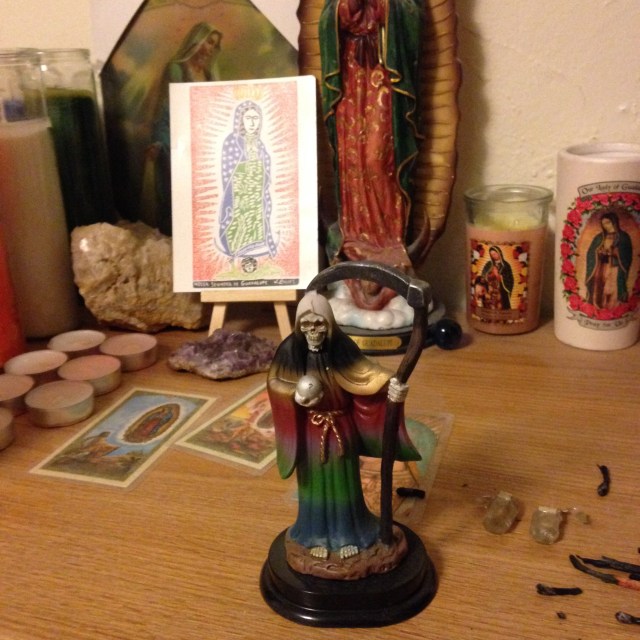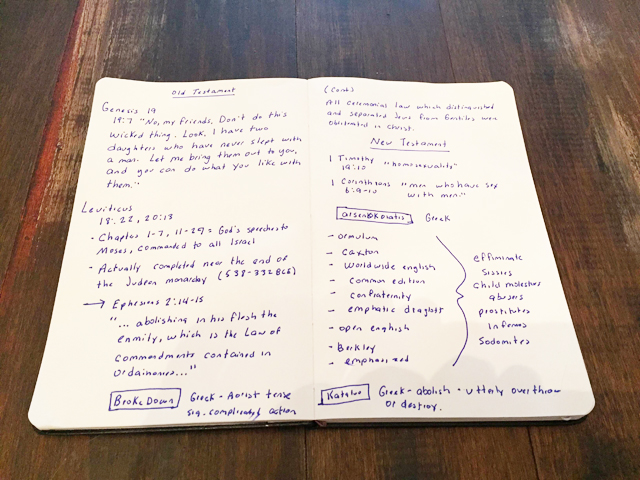Queer people raised Christian grapple with that background in myriad ways. Some of us become atheists, and some of us become pastors. Some queer Christians go to church twice a week, and others stick our rosaries in the bottom of our sock drawer. When faith, spirituality, and cultural practice feel complicated and contradictory, it can help to have a physical object to hold onto and reflect upon. These items can root us to our histories of faith — or they may simply be a symbol of old memories. In an A-Camp panel on queer Christianity called Thank You Lesbian Jesus, we talked about some of the items that connect us to our faith and spiritual journeys. Share yours in the comments!
Audrey — My Dad’s Bible
My dad’s death in 2001 sparked my first major faith crisis. It was the first time I seriously questioned the nature of God and interrogated Them beyond what I had learned in Sunday School. So it’s fitting, or perhaps ironic, that my favorite Bible is his, the one my mother snagged from his house to keep for me. His mother, for whom I have my middle name, gave it to him in 1972. I know this from the inscription on the inside cover. It is a very early copy of The Living Bible, which is paraphrase of the American Standard Version. A paraphrase! Because of that, it is pleasant to read and not very useful for actual theological study.

The book is also gorgeous — the cover is a deep green embossed with gold, and the pages are lightly worn and smell like the 70s. It’s the Bible I read when I don’t want to stare at the pages and pray rather than think too hard. And it’s the Bible I read when I want to connect to my dad. Our faith was something we shared and connected over when I was too little to understand it. My ongoing practice is one way that I connect with him and celebrate our relationship.
Carolyn W — Prayer Hands Tambourine

In theory the tambourine is not a piece of religious imagery. There is nothing sacred or holy about it. HOWEVER, if you were raised in a black church it is very sacred. One does not just play a tambourine. You beat that tambourine. Notice this tambourine has a percussion middle. This is important! Don’t you dare roll up in church with one of those rock & roll tambourines with no middle! What are you gonna do with that besides bruise your entire hand trying to play fast enough to keep the beat. Don’t you dare pick up a tambourine if you are not good at playing it. You don’t know you are good at playing a tambourine until you hear someone say “she sho can beat that tambourine.” If no one has ever said that to you then you better be very confident in your playing skills or you will receive the side-eye of death. There is always that one person that can’t play the tambourine who no one ever passes a tambourine to when the spirit gets high. One day they show up with their own tambourine that they bought and no one can take away from them and they ruin service for everybody with their sorry tambourine playing. And the tambourine battles? They are legendary. If someone challenges your tambourine skills, you better be ready for war!
All of this is funny but I do have a point in bringing up the tambourine. It represents the important cultural things that black folks attach to church. I once heard a black atheist friend say “I don’t believe in church but I will fight you if you try and take Jesus away from my granny and aunties that have been in church all of their lives.” Church is not always the religious or sacred imagery. For some it is an innate part of their cultural that they love.
Mey — Santa Muerte Statue
I’ve written many times before about how my faith is rooted in Mexican Catholicism and traditional witchcraft, and this is a perfect example of that. When I pray and when I do spells, I often go to La Virgen, but other times, I go to Santa Muerte, the Holy Death. She watches over and protects queer people, homeless people, sex workers, and everyone else. Just as everyone, no matter who or what they are, will die, everyone can come to Santa Muerte for protection and healing and help. When so many faiths and religions reject people like me, I find a lot of comfort in knowing that The Bony Lady will never abandon me.

My Santa Muerte statue at the front of my altar.
Furthermore, she helps me connect to my Mexican roots. When I’m praying at my altar or doing candle magic or giving offerings to La Santa Muerte after she’s helped me, I can feel myself drawing closer to my family and my ancestors and my people. I feel affirmed as a trans woman, as a lesbian and as a Chicana. La Santa Muerte is a great protector, an understanding saint and a reminder that I’m never alone, and this statue helps me to remember and feel all of that no matter where I am.
Heather — Research Journals
I loved the Bible and I loved the singing. That’s why I stayed in church so long. And when I say I loved the Bible, I mean I loved to study it. Has there ever been a more fascinating book in the history of the world? The way it was written, compiled, translated, censored, distributed, interpreted, reinterpreted, misinterpreted. Long before the Bible even existed as the Bible, the Apostle Paul called it a sword, and he was right. It’s been used as a weapon of destruction all over the world, for centuries now. I studied the Bible like it was my job, hours a day, every day. The Greek, the Hebrew, the Arabic, the translation of passages through time and the deep theology holding it all together. I left my Southern Baptist church and never looked back when it became clear to me that Evangelical Christianity had become a Fox News outpost, an unwitting herd of Republican party pawns. (My former Pastor is an Republican Congressman now; last time I was home in Georgia, I heard a dozen radio ads of him blasting President Obama’s godless liberal values.)

I’ve since parted ways with most of my faith, and nearly every physical thing that connected me to it. I have, however, kept my research journals. 27 full Moleskines in all. I’ll probably never know as much about anything (even lesbians on TV!) as I do about the Bible. But I also know I’ll never stop molding my life around the very first thing Jesus read out loud in the temple, the words of the Prophet Isaiah:
The Spirit of the Sovereign Lord is on me, because the Lord has anointed me to proclaim good news to the poor. He has sent me to bind up the brokenhearted, to proclaim freedom for the captives and release from darkness for the prisoners … to comfort all who mourn, and provide for those who grieve in Zion—to bestow on them a crown of beauty instead of ashes, the oil of joy instead of mourning, and a garment of praise instead of a spirit of despair.
I don’t believe in church anymore, but I do believe in my purpose on this earth.
Alaina — Icons
Like a good lifelong protestant Christian, I don’t have many icons or physical things that connect me to my religion. But part of my journey in queering Christianity has been incorporating small things into my personal daily worship. I finally have an altar where I sit every morning to read my daily devotional, meditate, pull a tarot card, and write a bit. My favorite part of this morning ritual has been lighting sage to cleanse the air. Smell has already been powerful for me. The smell of sage quiets my mind and ushers me toward a more contemplative way of being. It puts a fresh start on each morning and helps me hone in on how I want my religion to guide each day. When I find myself straying from living intentionally as a Christian, I remember the smell of burning sage and am able to refocus my energy back towards living more Christlike.
![]()



This was really reassuring as a lesbian and as someone who believes in God. I’m glad I’m not alone
I feel the same way- I loved this article and loved seeing the beautiful connections to faith. Thank you for this roundtable
It can definitely feel that way but you are not! ps. Let’s all meet and hang out at A Camp sometime? :)
You’re not alone! Jewish queer lady here, and fairly religious (regular synagogue attendance, don’t eat pork or shellfish, et cetera).
I’m with you too.
This is really cool; thank you for sharing.
I recently came across a definition of spirituality that really spoke to me. It comes from Brene Brown, a lot of her work is centered around shame, guilt, fear and overcoming these things.
“Spirituality is recognizing and celebrating that we are all inextricably connected to each other by a power greater than all of us, and that our connection to that power and to one another is grounded in love and compassion. Practicing spirituality brings a sense of perspective, meaning, and purpose to our lives.”
For some this may come off as obvious, but it speaks a lot to the struggle I have had with faith since coming to terms with my sexuality. I like to think about and examine the spiritual quality of the world we live in, but have a hard time believing that we as humans would be able to craft infallible institutions with our limited knowledge.
There is definitely something to be said for cultural relevance though, and being raised in a Catholic family has a lot to do with how I understand myself. I have a “Y”-Cross that I bought when I was traveling. The cross is actually shaped like a “Y” instead of the traditional “t” and when the artist was asked about its significance he said that when he looked upon the cross he would ask “Why would Christ die for me in this way?” and the answer that repeatedly came to him was “Because I love you.” Which goes back to that original definition that I posted. Spirituality has its roots in love. Cool stuff.
Thanks for this. My relationship with faith is ever complicated, but ever present. I find this article at once reassuring and challenging (but challenge is good/important). I get sad that my community forever walk away from faith even whilst I *utterly* understand why and am also feeling the pull, as the injustices rain down and the Christian right forever belittles and dehumanises us (who would want their God?). I wonder if holding onto this fraying thread of faith is worth how incredibly isolating doing so feels and the misunderstanding of my many excellent, highly queer, highly feminist, highly critical friends who love me but can’t understand why I would choose this.
How does one manage pain/isolation and still feel joy and hope in God’s power and justice and promise? This is one of the hardest questions to answer, and it becomes harder, even whilst trying to find the answer makes me feel like I’m on the right track to sitting fully within the messy challenges of this life and being a better person (and Christian) for it.
I was reminded again however recently within a devotion about David and the value of lamentation. Perhaps it’s a good time to get very honest and very sad and mad, you know?
On the article, I love the idea of burning sage and having a morning ritual and an altar. I know the Bible’s got a few thoughts on stealing but mind if I take that one? :)
I just realised Alaina that you’re working with Common Prayer too – I’ve got this one hanging out ready to dive into and I think you’ve just reignited that interest!
This is really beautiful. Thank you so much for sharing it.
When I was trying to get more habitual and intentional about praying (right about the same time I was figuring out and coming to terms with my sexuality, hmm) I discovered that lighting candles helped me focus, so I made a set of candle holders, one for each of my patron saints. I used purple for Saint Anne, because I was feeling lost and confused and if I couldn’t talk about it yet with my own family I could at least take comfort in trusting that Jesus’s grandma would be there for me in a special way. Later I realized that all three of them together make the bi pride flag, so that’s also cool.
Flannery O’Connor’s always been meaningful to me while working through queer Catholicism, too, and I have a prayer card from her museum–“O Raphael, lead us towards those we are waiting for, those who are waiting for us!”
Flannery O’Connor has been a really important factor in my faith as well. I was raised Catholic and have attended Catholic schools my entire life (including university), but after a very long and confusing journey, I don’t think I am anymore. Regardless, Catholicism is an inescapable part of my future, and a part of my past that has yielded as many good things as it has bad, and O’Connor’s writing has made Catholic spirituality something much more dynamic in my life. She makes Catholicism undeniably social, without applying it to society in the way that happens so often today (the reason I, and so many other queer people, have felt uncomfortable/unwelcome in the Church). While I don’t think I’ll ever return to the Church–I left for the gays and stayed away for the theology–O’Connor has made me enjoy Catholicism in an unexpected way, and made me comfortable with the fact I’ll never really leave it behind.
(I don’t comment much, but I actually got out my laptop and logged in because my love for Flannery is so strong.)
Loved reading all your interesting perspectives . Would have been amazing to be able to be at this panel!
Grew up Catholic but went to an Anglican (Episcopalian) high-school so have dabbled in both catholicism and protestantism.
My ‘faith object’ was stolen 18 months ago when my apartment got burgled and I still get really upset thinking about it. I used to have my great-grandmothers Rosary. She was like a mother to my Dad and I’m named after her. He has all these stories about her wise sayings, great faith and her knowledge of herbs and remedies in their little village in Bohemia making her sound like some kind of central European witch out of a storybook. My Dad took the beads when he travelled the world and moved abroad and he gave them to me to take on my travels and moving abroad. I had them stored with my passport case and this idiot burglar just grabbed the lot. Replacing the electronics and passports he stole sucked but was nothing compared to my devastation about the beads.
I keep trying to remember that the beads were just an object, and everything they symbolised exists without them in my life.
I went to church at Easter for the first time in ages. Was a toss up between finding a (perhaps) more progressive protestant church or the local Catholic one… I’m only intermediate-ish at the local language so follow the gist and miss the nuances of the sermon anyway. I was glad that in the end I chose the Catholic one. I let the familiar rituals and prayers wash over me and had a ‘moment’ thinking about Catholicism as my faith heritage. Regardless the many fucked up aspects of the church and regardless of my own interpretation and beliefs, these are centuries old rituals of spirituality that held so much beauty and importance to my fore-mothers and I was sitting there listening to it in their language and thinking about faith traditions as their gift to me.
I am a queer witch who loves Jesus, and I greatly appreciate this!
This lovely and timely. I’ve been thinking about this as I get ready to march in the Pride a Parade with my church later this month.
I’m still not sure which part of that sentence surprises me more, but I think it’s that I belong to a church.
I’m not sure I have a faith object but I have a root practice – Centering Prayer / meditation. It’s what allowed me to come back to Christianity.
I do have a small Madonna icon that belonged to my Catholic grandmother and a prayer book from my Episcopalian grandmother.
I’d never heard of Santa Muerte before. I really loved Mey’s thoughts on her.
I never really felt connected to Christianity in a spiritually meaningful way growing up only a cultural connection to Catholicism andddd some fucked philosophical ideas on self denial, the Seven Deadly Sins.
But a developed a Marian devotion as young teenager when I was obsessed with Maiden, Mother and Crone archetypes and started to find my way spiritually in music and singing. The Stabat Mater in a musical setting was a revelation. It let me grieve for child that was hurt, start to work through some of the rage and started me on the path of moving music that wasn’t as aggressive as metal but still as powerful and expressive.
I never was spiritual person or understood spirituality, but always understood that religion/faith/spirituality is a comfort to people and world is not a kind or fair place.
Still not a theist that’s just not in my nature be it by the childhood I had or just the inquisitive way of my mind that prefers proof and logic.
Trinities fascinate me so it is rather fitting that there are three tangible things:
1) King cake
2) a Pre-Vatican II copy of the Roman missal
3) my Mater Dolorosa drawings and doodles
A song is not as tangible as physical objects but La Grace Du Ciel thematically ties all three of those things together for me and I’m a galdrkona, a witch that sings so it feels important enough to mention.
1) It’s in Cajun French, a cultural connection
2) The lyrics while beautiful to me do not relate to my spirituality
3) It is sorrowful for me, it’s beautiful and channels my grief. The grief is for my granfather, watching him die slowly for 3 years, for not finishing learning the song in time for his funeral, for the slow death of the Cajun language and culture, for the fact it is foreign language to me and Spanish is not.
I can reconcile how I feel with it. I’m not lost in my grief, but found in a way to express it and that is a healthy thing. I use to bottle so much, try to be as strong and silent as stone but now I sing.
If you approximate a Christian queer*, Metropolitan Community Church is a queer-focused progressive church.
I’ve only ever been to the one in Seattle, but it’s extremely rad!
* I describe myself as a Catholic Jedi
Good blog you have here.. It’s hard to find quality writing like yours these days.
I truly appreciate people like you! Take care!!
I loved every bit of this, but then as a queer Anglican vicar/pastor I would! My most meaningful faith-related objects right now are my ammonite fossil (keeps me connected to St Hilda, one of my faves), tarot cards, and collections of old hymnals and prayer books that I scribble in.
Someday I want to get a print of this painting called ‘Emmaus’ by Emmanuel Garibay which shows a resurrected Jesus as a woman sitting around the table with her friends, eating, drinking and laughing.
Attending this panel was just…so formative. Incredibly helpful for my own meditations and just…reassuring to know that I wasn’t alone in feeling that exploring my faith often felt like a betrayal of my queerness. BUT speaking with all of you about matters of the spirit helped me to connect the part of my faith that REAFFIRMS my queerness. Y’all are angels (if you’re into that kind of stuff).
Love seeing this kind of article on AS! As a queer Christian with backgrounds in Baptist and Mennonite traditions, I agree with Harry that it can feel isolating to try to live in both the LGBTQ community and the faith community. Many of my former life-long Christian friends are still coming to terms with queer issues and many of my new secular, liberal-minded queer friendly-friends make fun of and simply don’t understand spirituality. (It makes planning a wedding ceremony very challenging when you want to incorporate faith traditions yet have many non-believing friends).
I love Heather’s highlight of the verse in Isaiah. I love that as a life purpose! And I agree with the sentiment that even if I cannot embrace every aspect of Biblical teaching as a queer feminist, I still love the Bible as an incredible religious text- there are so many beautiful passages and moving stories.
My object that helps me stay rooted in my faith is my Mennonite hymn book. It holds so many memories and truths in the songs. When I sing through my favorite hymns, I am reminded of the beauty, grace and joy in the Christian faith.
I hope that conversations like this help the LGBT community and the Church community continue to make both groups feel welcome in their spaces and individual lives.
I’ve been raised catholic, strayed away from it when I was in high school but came back when I was in uni. When I came out to my parents I turned to God to give me strength and prayed for courage. If I had to pick an item(s) I’d have to go with.
1.) the rosary I got for my first Holy Communion
2.) The 3 different bibles I have. The smallest one is a pocket sized new testament that I got when I was 11 and only found it again recently.
I am a queer, progressive, sex positive, inclusive, islamophobia-fighting, we’ve-got-room-for-all y’all-even-you-on-the-Right, clergy person who is a FOOL for Jesus, who has never found the Bible to be the center of her faith. That said, I absolutely ADORE the Bible and own about 20 of them. As a scholar, I can totally geek out on issues of translation, the contextualities of author and readership, and how queer theory breaks it all wide open.
In brief, coming out in college, I knew I might be risking my family, my friends but that God would never leave me. In fact, It was God herself calling me forward into this new way of knowing and being myself. (or, if that “G” word is too laden for you, please insert: The Sacred, Higher Power, Source, the Holy, Howard, JC or whomever feels right for you.)
I look forward to talking about all manner of sexuality and faith with any who like this summer. Can’t wait to meet you all.